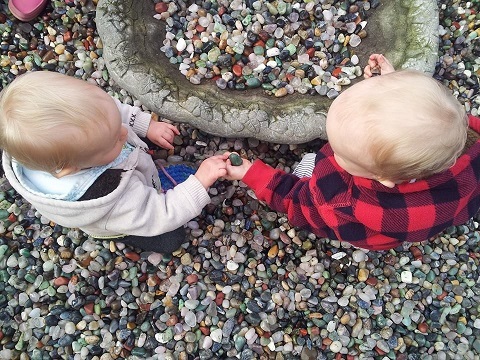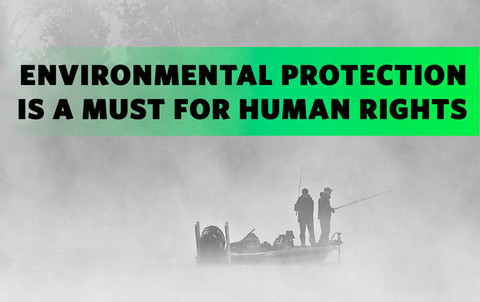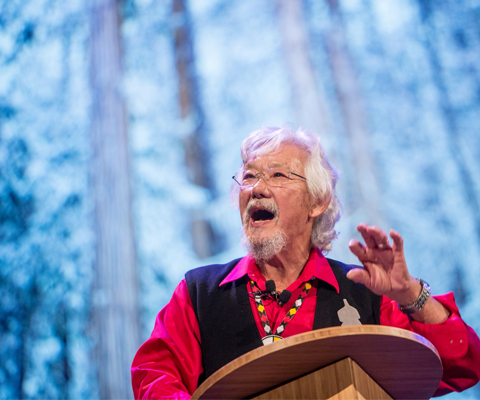David Suzuki's Blog, page 42
March 16, 2016
How to protect kids' brains

One hundred per cent of kids have lead in their blood yet there are no safe levels of lead.(Credit: Brendon Purdy Photography)
Not all chemicals are bad.
But I suggest everyone -- not just parents -- watch Little Things Matter: the Impact of Toxins on the Developing Brain, narrated by Bruce Lanphear.
"We've discovered that extremely low levels of toxins can impact brain development," he says. "We have also discovered that subtle shifts in the intellectual abilities of individual children have a big impact on the number of children in a population that are challenged or gifted."
Toxins can't be ignored:
They have lifelong impact.
Even low levels affect kids' brain development.
One hundred per cent of kids have lead in their blood. There are no safe levels of lead!
One hundred per cent of kids have PCBs (used in the manufacturing of electrical equipment, heat exchangers and other specialized applications up to the late 1970s).
One hundred per cent of kids have PBDEs (flame retardants).
Ninety-six per cent of kids have BPA (a hormone disruptor).
Eighty-nine per cent of kids have mercury.
We regulate as if there are safe levels.
We're exposed to many chemicals, including some that have never been tested.
Lanphear recommends five ways to lower body burden:
Eat fresh and frozen foods.
Remove all lead hazards, especially in homes older than 1960 (e.g., pipes).
Choose low-mercury fish.
Clean floors, surfaces and house dust.
Avoid using pesticides.
This is only a quick summary of a serious subject. For more details, please watch the full seven-minute video.
Have you found ways to eliminate kids' exposure to toxins -- lead, mercury, BPA, PBDEs?
Sincerely,
Lindsay Coulter, a fellow Queen of Green
Hey! Want more DSF? Join David Suzuki on Facebook

March 15, 2016
Tell the Canadian government a healthy environment is a human right

Tell our federal government to adopt the UN's recommendations to protect human rights through strong environmental protections.
Hey! Want more DSF? Join David Suzuki on Facebook

March 11, 2016
Write a letter to the editor to link environmental protection to human rights

March 10, 2016
Change is in the air

(Credit: kris krüg via Flickr).
When Archduke Franz Ferdinand of Austria was assassinated in June 1914, no one thought, "Uh-oh, World War I is starting..." We only recognize the significance of events in the context of history. I recently had a day like any other except it made me wonder if we're on the verge of historical change.
On March 2, 2016, I woke to CBC's Early Edition and heard program host Rick Cluff interviewing Canada's Minster of the Environment and Climate Change, Catherine McKenna. She was explaining her infant government's intention to meet the emissions targets set in Paris in December. That was followed by an interview with Canadian Labour Congress president Hassan Yussuff, talking about his organization embracing the need to address climate change with a proposal to create a million "climate jobs" over the next five years. It all struck me as amazing after a decade when little attention was paid to climate change at the federal level.
I hopped out of bed with excitement. Walking to the bus stop, I was hailed by my neighbour, the eminent architect Bing Thom, who invited me to squeeze into his Mini Minor. As we drove downtown, he was anxious to talk about the energy future and how it related to his job designing places to live and work. "We have to be bold, because climate change is so urgent," he repeated several times.
As he let me off at the Fairmont Waterfront hotel, I wondered if I was still asleep and dreaming. I then noticed a number of identical bicycles at the hotel entrance. When I asked a manager whether they're for rent, he replied, "They're for our hotel customers on a first-come, first-served basis." I asked whether they were used much. "All the time. People love them," he answered. He then asked if I had seen the rooftop garden. "We have five beehives up there that produce 500 pounds of honey a year," he boasted.
I was at the hotel to join Yussuff for a news conference about the CLC's plan, called "One Million Climate Jobs: A Challenge for Canada."
As Yussuff and I chatted before the event, I asked how he had come to take climate change so seriously. "I have a seven-year-old daughter, and my greatest concern is the world we are leaving her," he said, "Climate change is going to have a profound effect on her life." I responded that, as a grandfather, I shared his concern. We agreed that the problem for politicians is that they think in terms of election cycles, which demand that whatever they do will pay off before they return to the polls.
At the news conference, I thanked and congratulated the CLC for the forward-thinking idea that the challenge of climate change presents an opportunity. British Columbians, I said, are at the frontlines of climate change. We've seen billions of dollars of pine trees destroyed by mountain pine beetles that are no longer suppressed by cold winters, massive fires that have caused enormous economic loss, a drought in the heart of the coastal rainforest, shellfish killed by ocean acidification and changes in growing seasons.
By embracing scientific information about the warming planet and committing to avoid a catastrophic temperature increase this century, we create a huge opportunity that groups like the CLC propose we exploit.
The reporters wanted to know what specific proposals we had to reduce greenhouse gas emissions. I pointed out the important hurdle was to commit to reduce emissions, because until we start, we won't know what opportunities will arise. I reminded them that in 1961 when President John F. Kennedy said the U.S. would get American astronauts safely to the moon and back in a decade, no one knew how they were going to do it.
Amazingly, not only did they achieve the goal before the decade was over, there were hundreds of totally unanticipated spinoffs, including laptops, cellphones, GPS, ear thermometers and space blankets. I am absolutely certain the same will happen when we commit to avoiding chaotic climate change.
This day wasn't much different than the day before or the next one, but it made me feel that a revolution is already underway.
Hey! Want more DSF? Join David Suzuki on Facebook

Write a letter to the editor to link environmental protection to human rights

Hey! Want more DSF? Join David Suzuki on Facebook

March 7, 2016
Stronger environmental legislation and regulations needed for Canada to meet human rights says UN committee
A United Nations committee today recommended that Canada improve environmental regulations, address climate change and pursue renewable energy to protect human rights, particularly for indigenous people.
"It is clear from the UN committee's assessment that although Canada prides itself on its human rights record, it must do more to protect the foundation of those rights -- a healthy and productive environment," said Jay Ritchlin, David Suzuki Foundation director for Western Canada. "The committee agreed with us that stronger environmental protections are essential to safeguard our human rights."
The committee pointed to weakened environmental regulations following Bill C-38 (officially, "an Act to implement certain provisions of the budget"). It recommended that environmental impact assessments be regularly carried out for extractive industry activities and that Canadian laws recognize the right to free, prior and informed consent of indigenous peoples. It also called for meaningful participation of indigenous peoples in decision-making related to development projects carried out on or near their lands.
"This signals that a business-as-usual approach must be off the table when it comes to development projects such as pipelines and large hydro projects," said Ritchlin.
Lack of action on climate change, particularly in relation to indigenous people, was also an area of concern for the committee, which recommended non-conventional fossil energy use must be preceded by consultation with affected communities.
"This international body agrees with Canadians that Canada must pursue alternative and renewable energy production, and that climate change obligations are also human rights obligations," said Foundation director of science and policy Ian Bruce. "It's another compelling reason to transition our economy away from damaging fossil fuel production towards cleaner and safer sources of energy."
The Foundation's submission to the committee included references to more than 1,500 written, oral and video stories collected from 12 coastal B.C. communities, including 12 First Nations, during 2015's Celebrating Coastal Connections tour. The culture, identity and livelihoods of coastal people depend on the bounty of the ocean, the Foundation argued, and Canada must take immediate action to protect the Pacific coastal environment. During the review, the committee questioned Canada's lack of protection for coastal environments and recommended that Canada must also protect access to traditional food. "This broadens the discussion to all ocean ecosystems and important food sources such as salmon," said Ritchlin.
This is the first time in a decade that the United Nations Committee on Economic, Social and Cultural Rights reviewed Canada's rights performance. The review took place from February 21 to March 5, 2016. The recommendations from the committee follow a David Suzuki Foundation submission that examined how Canada's failure to meet international human rights obligations is linked to reduced environmental regulations and oversight.
The UN committee's concluding observations for Canada: http://tbinternet.ohchr.org/_layouts/treatybodyexternal/Download.aspx?symbolno=E%2fC.12%2fCAN%2fCO%2f6&Lang=en
Media contacts:
Panos Grames
604-970-9906
Theresa Beer
778-874-3396
Hey! Want more DSF? Join David Suzuki on Facebook

March 6, 2016
How to "green" your toddler

Learn how to avoid toxic chemicals that are persistent and bioaccumulative, which means they build up in the environment and our bodies. (Credit: Brendon Purdy Photography)
As a parent, you're probably losing sleep.
It might not be because you're thinking about the eco-friendliest pyjamas, pillows or straws... but reducing your child's exposure to toxic chemicals can help you rest easier.
By the end of this article you will:
Want snug-fit PJs for your kids
Have an urge to dust
Know another way to help protect oceans and wildlife from plastic
Choose snug-fit, certified organic pyjamas not treated with flame retardants.
Avoid synthetics like polyester. Polyester is plastic (which melts) and has flame retardants built into the fibres. Avoid loose-fitting pyjamas, which are more likely to catch fire.
Shop local thrift and consignment stores -- that's right, you can score organic clothing there! --or try My Little Green Shop, New Jammies, Parade Baby, Simply Merino and Underables, to name a few.
Studies show that consumer products -- not industrial emissions -- are the likely source of the buildup of flame retardants, or PBDEs, in people and animals.
These toxic chemicals -- found in furniture, carpets and electronics -- have been linked to cancer, adverse effects on the developing brain, and immune and reproductive problems. They are also persistent and bioaccumulative, which means they build up in the environment and our bodies.
The solution? Dust!
Household dust is now recognized as one of the most significant sources of childhood exposure to toxic substances because it's really a chemical soup with low levels of flame retardants, pesticides, phthalates and metals like lead, mercury and arsenic.
Choose pillows made from the eco-friendliest materials: wool, natural rubber, kapok or organic cotton.
If you're lucky, your toddler's head rests 11 to 13 hours each day on a pillow. But what's that pillow made of?
Avoid pillows made from synthetics like petroleum-based polyester. Natural fabrics and fibres are better because they won't off-gas. Some down and feathers used in pillows (comforters and jackets, too) are harvested from live or force-fed birds. And some down pillows contain feathers sterilized with formaldehyde -- a known carcinogen.
Pillows are not recommended for babies under 12 months. Choose a low-loft pillow for toddlers.
Wool is naturally resistant to dust mites and mildew. It needs to be spot-cleaned.
Natural rubber is resistant to mold, fungus, mildew and dust mites. It's also renewable and biodegradable.
Silky threads from the flower seeds of kapok trees are harvested without chopping down the trees.
Organic cotton breathes and, free my chemicals and dyes, is better for the environment. It's popular among people with allergies or sensitive skin.
Retailers of eco-friendly bedding and beds include Organic Lifestyle, inBed Organics, and Obasan
Choose reusable, recyclable stainless steel plates, cutlery, lunch kits, straws, etc.
Plastics are widely used because they're cheap and often durable. But most contain toxic chemicals, as softeners or to make them resistant to ultraviolet light.
Health Canada says that 95 per cent of Canadians have measurable levels of Bisphenol-A (BPA) in their blood or urine, with the highest levels found in children. Potential health effects from BPA exposure include breast and prostate cancer, attention deficit hyperactivity disorder (ADHD) and a wide range of developmental problems. And phthalates (pronounced "thal-ates") are increasingly linked to endocrine disruption (interfering with hormone function), and reproductive and developmental problems, among other health effects.
Shop for dishware that's free of BPA, PVC (polyvinyl chloride), phthalates, and lead and cadmium (or other heavy metals). Places to source non-toxic, air-tight, leak-proof and dishwasher-safe options include ECO lunchbox and Onyx Containers.
What other "green" toddler items do you recommend? Comment on this blog to win toddler pajamas made by Skylar Luna and donated by Underables, a toddler pillow donated by Organic Lifestyle and stainless steel straws and children's cutlery donated by Onyx. (Draw date: April 11, 2016)
Sincerely,
Lindsay Coulter, a fellow Queen of Green
Hey! Want more DSF? Join David Suzuki on Facebook

March 3, 2016
Will cap-and-trade slow climate change?

(Credit: kris krüg via Flickr)
The principle that polluters should pay for the waste they create has led many experts to urge governments to put a price on carbon emissions. One method is the sometimes controversial cap-and-trade. Quebec, California and the European Union have already adopted cap-and-trade, and Ontario will join Quebec and California's system in January 2017. But is it a good way to address climate change?
The program sets an overall limit -- a cap -- on the amount of greenhouse gas emissions a province can emit. It then tells polluters, such as heavy industry and electricity generators, how many tonnes of carbon each can release. For every tonne, polluters need a permit or "allowance." So, if a company's annual limit is 25,000 tonnes, it would require 25,000 allowances. If a company exceeds its limit, it can purchase additional allowances from another firm that, because of its greater efficiency, has more allowances than it needs. This is the "trade" part of the equation.
Although an individual company can exceed its greenhouse gas limit by purchasing credits, the province as a whole can't. The overall limit is reduced every year, so if the law is followed, cap-and-trade guarantees annual emissions reductions. The declining cap is the system's great strength and the way it protects the environment.
How effective is it? Although the answer isn't straightforward, there's evidence cap-and-trade played a key role in reducing acid rain in the United States. The 1990 Clean Air Act allowed power plants to buy and sell the right to emit sulphur dioxide. Since then, U.S. sulphur dioxide concentrations have gone down by more than 75 per cent. As Nobel Prize-winning economist Paul Krugman wrote in the New York Times, "Acid rain did not disappear as a problem, but it was significantly mitigated."
Despite this and other successes, some experts are skeptical, arguing that cap-and-trade amounts to little more than a cash grab by government, a tax in everything but name. Others say it's a mistake to expect climate change can be addressed through markets, when the problem actually requires changing our entire approach to economics, with a commitment to a steady-state economy and an end to the commodification of nature.
Some experts have also noted that the emissions reductions it brings are often modest. A 2015 paper in Canadian Public Policy claimed Quebec's system "is still too weak to meaningfully address the environmental imperatives as outlined in the Intergovernmental Panel on Climate Change's 2014 Fifth Assessment Synthesis Report, in which fully eliminating carbon emissions is the benchmark for long-term policy goals." From 2013 to 2014, California's allowance cap went from 162.8 to 159.7 megatonnes, a drop of less than two per cent.
Ontario's proposed legislation indicates its program will have some great strengths and a number of shortcomings. It will likely have wide coverage, applying limits on most of the province's emissions, including those from transportation fuels. (California's system did not initially include these fuels.)
Ontario is expected to reduce emissions by over four per cent a year -- about twice the initial rate of California -- and generate $1.9 billion annually from the plan. That money will be invested in "green" projects throughout the province with the goal of reducing carbon emissions even further.
Ontario's proposal to give away many allowances to big emitters is less encouraging. The government says it will eventually phase out this free disbursement, but in the meantime millions of dollars in government revenue that could be used to support renewable energy and public transit will be lost.
To keep the bulk of fossil fuels in the ground -- as scientific evidence says we must -- we need a variety of strategies. Cap-and-trade helps reduce emissions and generates billions of dollars for other strategies to address climate change. It also embodies the polluter pays principle. But it's not enough on its own.
The David Suzuki Foundation and others have long argued that provinces and the federal government should put a price on carbon, through carbon taxes, cap-and-trade or a combination of both. The urgent need to address global warming means provinces that have adopted cap-and-trade need to strengthen it by ensuring emissions drop faster and polluters pay a price that truly reflects the damage caused by carbon pollution.
Hey! Want more DSF? Join David Suzuki on Facebook

March 2, 2016
Ecojustice and the David Suzuki Foundation applaud Manitoba's Environmental Rights Act
Winnipeg, M.B. -- Ecojustice and the David Suzuki Foundation issued the following statement in response to the introduction of Manitoba's Environmental Rights Act:
"Today Manitoba took an important step toward ensuring that every person in the province has the right to clean air, safe drinking water and a stable climate. The right to a healthy environment is a concept that transcends political lines, and we applaud the government and Manitobans who worked hard to support this critical issue," said Kaitlyn Mitchell, Ecojustice lawyer.
"Manitoba has taken the important step of recognizing a substantive right to a healthy environment -- a right which a majority of Canadians overwhelmingly support. We now hope to see legislators of all political stripes work together to make the Environmental Rights Act law."
"This is an inspiring example of a government taking leadership by working within their authority to respect, fulfil and promote the right to live in a healthy environment," added Alaya Boisvert, David Suzuki Foundation manager of Blue Dot government and partner relations.
"By recognizing and protecting environmental rights, Manitoba can support sustainable prosperity, reduce deaths and illnesses linked to pollution, and advance environmental justice. The bill will enshrine in law the deep connection between the quality of our environment and our human right to life, liberty and dignity."
The David Suzuki Foundation and Ecojustice are partners in the Blue Dot movement, a national grassroots campaign to advance the legal protection of every Canadian's right to live in a healthy environment. In just 18 months, thousands of Canadians from coast to coast to coast have mobilized around the concept of environmental rights and urged their governments to take action. To date, more than 120 municipalities -- representing 12 million Canadians -- have passed declarations in support of the right to a healthy environment.
"Environmental rights are human rights. Around the globe, the right to a healthy environment has gained legal recognition faster than any other human right during the last 50 years. It's time for Canada's laws to catch up," said Mitchell.
For media inquiries
Kaitlyn Mitchell, Lawyer | Ecojustice
647 746 8702
Alaya Boisvert, Manager of Blue Dot Government and Partner Relations | David Suzuki Foundation
604 562 2779
Theresa Beer, Communications Specialist | David Suzuki Foundation
778 874 3396
Hey! Want more DSF? Join David Suzuki on Facebook

Select B.C. rockfish now recommended by Vancouver Aquarium's Ocean Wise® Program
Vancouver, B.C. -- Some species of B.C. rockfish (Sebastes) are now recommended by Vancouver Aquarium's Ocean Wise program following the release of an updated assessment on groundfish, a group that includes bottom-dwellers such as halibut, lingcod and rockfish. Rockfish, a whitefish popular among consumers, is found along the Pacific Coast from California to Alaska.
All rockfish fished along the B.C. coast had previously been not recommended by Ocean Wise, due in part to habitat impacts associated with bottom trawl fishing gear, which is towed along the seafloor to gather catch. Midwater trawling involves towing a net in the water column above the seafloor and allows targeted fishing of rockfish in those areas. The recent assessment of midwater trawling methods released on Tuesday by Seafood Watch and SeaChoice has helped to recognize the environmental performance of the two different fishing practices. Ocean Wise criteria were applied to the updated assessment, leading to a recommendation for midwater-trawled rockfish. This sharing of information and knowledge among organizations allows for a collaborative approach to raising awareness about sustainable fishing across the industry and among consumers.
The new report lists four species of rockfish that are midwater-trawled as sustainable options: yellowtail, yellowmouth, silvergray and canary rockfish. In the case of yellowtail rockfish, a recent government stock assessment that indicates a healthy stock was also made available, which further increased their assessment score.
"There have been significant strides in the management of B.C. groundfish over the past 20 years. With this latest recognition of midwater trawl-caught rockfish, consumers will now find the Ocean Wise symbol next to select B.C. rockfish that have been reclassified by the Vancouver Aquarium and are now considered sustainable options," said Ann-Marie Copping, Vancouver Aquarium's Ocean Wise program manager. "We encourage consumers, whether they're visiting their local fishmonger or out for dinner at an Ocean Wise partner restaurant, to inquire about where their seafood comes from and how it was fished. This collective curiosity will encourage even more venues to offer sustainable seafood selections, which, in turn, will help continue to move the needle on sustainability and ensure the health of our oceans for generations to come."
Dr. Scott Wallace, senior research scientist at David Suzuki Foundation, has been working closely with the B.C. groundfish bottom trawl industry for close to a decade and has observed several improvements to reduce the industry's habitat impacts.
"These new rankings reflect the obvious fact that fishing completely away from the seafloor will result in the least amount of habitat impact. We hope recognition by Ocean Wise will provide an incentive to catch a greater proportion of these rockfish species using mid-water fishing gear," said Wallace. Currently only about one third of the allowable catch of these rockfish species are caught mid-water.
In addition to improved management, new technologies in the seafood industry enable fishermen to label their catch for traceability purposes, so retailers, chefs and ultimately consumers can track the rockfish from ocean to table.
Chef Ned Bell of YEW seafood + bar was recently recognized as a champion of sustainable seafood with the B.C. Coastal Artist Award at the Vancouver Aquarium's Coastal Ocean Awards. Bell notes that assessments for local seafood provide valuable information to chefs.
"Having detailed knowledge about lesser-known local fish, including how, where and what is being caught, makes it much easier to cook, create and share new recipes with guests, peers and colleagues," said Bell. "Chefs value that information and I value the great work being done on the water by everyone involved for healthier fisheries and sustainable seafood options, such as B.C. rockfish."
The full assessment can be viewed here columbia_report.pdf.
**Media Contact
**Alexis Brown | Vancouver Aquarium | 604.659.3777 | alexis.brown@vanaqua.org
Scott Wallace |David Suzuki Foundation |778.558.3984 | swallace@davidsuzuki.org
Hey! Want more DSF? Join David Suzuki on Facebook

David Suzuki's Blog
- David Suzuki's profile
- 247 followers



